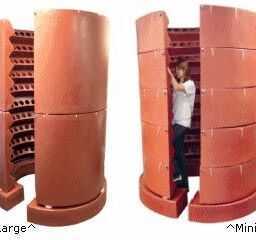A real, free energy device is something that delivers more electrical current than it consumes. I would also argue that when the costs of initial purchase, installation and maintenance of a free energy system are so high that they must be amortized over many years until they have been paid for by electric bill savings; such devices are not actually “free.” Let’s examine a few of the devices that are currently available to find out how they stack up.
Solar Electric
Although the cost of photo-voltaic panels is gradually lowering, they are still costly even if you learn how to manufacture them yourself. If all you required was the panels themselves, perhaps this expense could be justified. Unfortunately, there is much more to a solar installation than just the panels. To totally run a small house, you would require a minimum of about three thousand watts of electricity being delivered by the panels when connected together. If you use 100-watt panels, you would have to pay for thirty panels at around $250 each, giving you a total price of $7500 for the panels themselves.
For a larger house, you might have to have forty panels ($10,000) or 50 panels ($12,500). When you include labor expenses, inverters, wiring, electrical junction boxes, circuit breakers, permitting fees, a battery shed and solar batteries, you can easily watch your outlay climbing past thirty to forty thousand dollars before you even receive your first watt of free electrical current. Solar panels last a long time (20 to 30 years) but good solar batteries last just ten to twelve years and then have to be replaced. My solar battery bank is at the end of its predictable lifetime and I have recently been informed that the replacement price will be about $14,000 due to the rapidly climbing costs of lead! Ouch!
Depending on where you live, solar electricity could not even be possible. While solar might be justified in Miami, Florida, it most likely would not be in Seattle, Washington. Solar will work to some small degree on cloudy days but you will have to take into account the expected number of gray days in a year to find out how many additional solar panels will be needed to keep your batteries charged as compared to the number required in a sunnier climate.
Wind Energy
Wind electricity calls for the purchase of a wind turbine and, ordinarily, a tower to lift up the wind turbine up into the wind stream. Mounting a windmill on your roof is a bad choice unless you like extreme noise and vibration. Again, like solar, you are faced with the need for a battery bank, inverters, wiring and installation and so you will see a lot of dollars fly out the window before the lights go on.
Unlike solar panels, wind turbines don’t have a very long life expectancy because of their constantly-moving internal parts. There are also rust factors to think about especially if you live near the ocean due to the ravages of salt air on the metal parts. Again, wind power might not be a good choice unless you live in a place with dependably steady wind conditions with sufficient but not too much wind velocity.
The Tesla Cosmic Energy Generator
Nikola Tesla was an inventor of the early twentieth century who was way ahead of his time. If there was a problem associated with electricity or electrical power generation, Tesla always seemed to have a solution. However, he was put down by the powerful business interests of the day who did not want to see his ideas take hold for the reason that they would compete with their very profitable, existing businesses. One of his numerous inventions that still survives in our day is his electrical generator design that runs on the constant electrical power of the cosmic rays that surround this planet.
With these cosmic rays acting as one side of the electrical circuit and the earth, itself, as the other, electrical power can be created with no moving parts. A little, proof-of-concept device is able to be built from a few dollars of parts from your local Radio Shack® store. This miniature device will only yield enough current to power a cell phone charger. However, using the same idea, a device big enough to electrify a whole house can be built reasonably from widely-available plans. To date, you will not observe such a device being fabricated for sale but you can easily construct your own device if you follow the detailed directions and drawings precisely.
The Permanent Magnet Electrical Generator
This device is actually a perpetual motion machine that we all were taught can’t exist. The only problem with that old belief is that hundreds, if not thousands, of these generators have already been built and are functioning just fine, thank you. A small proof-of-concept machine can be created from about $100 worth of parts which you can pick up at your local Home Depot® store. A bigger machine (sufficient to electrify a small house) can be created for somewhat more money. A big house might need two of these generators operating in parallel.
A permanent magnet electrical generator is much like to an ordinary electrical generator. The difference is that the motor powering the generator, in place of burning gasoline or Diesel fuel, operates on the power of permanent magnets alone. You undoubtedly have heard that when you place electricity into a standard electrical motor, it will begin to turn and when you turn the shaft of such a motor with another motor, it will produce electricity. The permanent magnet electrical generator requires no supply of external power to run. The small amount of power that it does need constitutes only around one fifth of what it is creating, so four fifths is available as absolutely free energy. An apparatus that creates precisely the power it requires to operate (and no more) is said to be operating at “unity.” A mechanism that delivers more that it requires to run is said to be functioning at “over-unity.”
The permanent magnet electrical generator and the Tesla cosmic ray generator both yield free energy without using fossil fuels or electrical power from the power company. They will run indoors impeccably in almost any climate, day and night. They emit no exhaust, fumes or other toxic vapors so they can be safely positioned inside a house or apartment. The only problem is that you, for the time being, have to build them yourself from available and inexpensive plans.
It’s not too challenging for me to choose what my next “free energy” system will be. There are only two systems that make any sense and they are not solar or wind.
© 2011 Robert M. Gillespie, Jr.
AUTOPOST by BEDEWY VISIT GAHZLY


